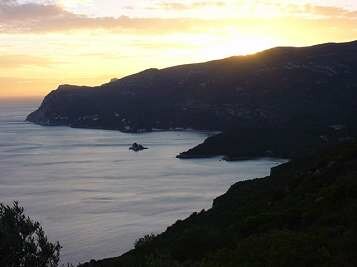Arrabida Mountains

The
District of Setúbal has a total area of 5,100 Km2 (5.7% of area of Continental
Portugal) and integrates a vast massif, which goes from Palmela to the Espichel
Cape.
One
of the elements of this massif is called since long ago the Arrábida Mountains.
The others are the Risco Mts; the S. Luis Mts; the S. Paulo Mts; the S.
Francisco Mts; the Louro Mts; the Gaiteiro Mts; and the Palmela Mts.
Whe
will detain ourselves some time in this orographic accident and its surroundings,
very celebrated and highly appreciated by its beauty and singularity.
In
this vast area, and mainly in the Risco Mts., S. Luis Mts. and Gaiteiro Mts.,
the calcareous pudding-stone is widely explored, and, it is used as a decorative
stone after adequate processing (polishing, etc.),.
The
Arrábida Mts. have been choosen since ever as the favourite ground for the
erection of defense posts, as the Castles of Sesimbra and Palmela, and the S.
Filipe Fortress.
The
Arrábida Mts have a great scientific interest in areas of knowledge such as the
Geology, Paleontology, Biology and Prehistory, among others. With regard to
these sciences, we should consider the inumerable caverns, grottos and dens,
spread all over the mountains, and presenting unforgetable moments to adventure
lovers.
The
extraordinary importance of the fauna and florest of the region has always been
carefully considered in the district of Setúbal, namely in what regards the
interesting and varied species of birds and plants that choose as habitat this
wonderful corner of the south-west of the Iberian Peninsula.
As
a small example of the privileged situation of the District of Setúbal, we
point out that the greatest number of nidificating birds are found there - 110,
according to the specialists. And we should stress the fact that many of the
species are absolutely unique.
Among
other places of interest, we can observe some sand islands along the base of the
Arrábida Mts, which represent a natural habitat very frequented: Cambalhão
Point (in the Sado mouth, in front of Tróia), and Cavalo Island, in the river.
Apparently solitary, they are however important zones of shellfish and an
excellent refuge for birds.
Rocky
islands as Pedra da Anicha and Pessegueiro are another curiosity, the last one
having been formerly inhabited.
azeitao.net, uma região a descobrir
© Todos os direitos reservados - Bernardo Costa Ramos